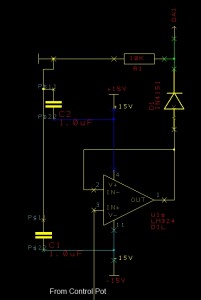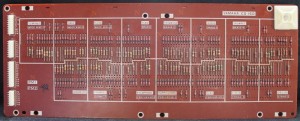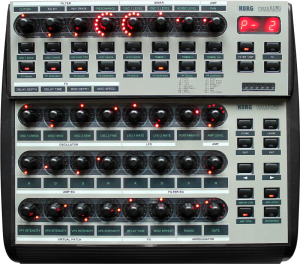Since I got my CS15D I´ve always known that one day I would make a certain modification to it, and this day has finally come: Manual control for channel 1.
Mod design
When I opened the synth the first time I was pretty surprised by what preset meant before the time of (affordable) digital memory! Each preset is a set of resistors defining the CV values of the parameters.
The channel 1 and 2 presets reside on distinct PCBs.
I eventually managed to grab a copy of the service manual, and it made it pretty obvious that it would not be too hard to replace the presets by controls. The service manual reveals that all parameter CVs use the same 10V voltage source. The preset selectors route this source to the respective preset subcircuit. Channel 1 manual mode is not so much different. The voltage source feeds the control pots that are buffered by op-amps.
The overal design of the synth proved execellent for the modification.
The preset selector switchboard can be easily unscrewed from the front panel and the panel slits provide enough space for the new pots.
The preset board for channel 1 can also just be unplugged and taken out, and the board connectors reused to feed and source the modification board.
This design makes it easy to replace the original components with the custom control modification without altering the original circuits or messing up the front panel.
Now the modification was pretty straight forward:
- Build a PCB with the driver op-amps, voltage source routing and board connectors.
- Build a control panel
It was not so complicated, but a lot of soldering work..
Once finished, I hooked it all up, switched on the synth and… It worked!
But just for a short time, which brings me to….
The Tr7 problem
A minute after I started calibration works on channel one, a flashy bang to my left silenced the audio output of the CS15. After a short notion of anger and a little fear I might have damaged an irreplaceable custom chip, I searched for the fault and located it soon: A transistor blew into pieces. Lucky enough the marking on the front was still readable, and a glance at the service manual revealed the function of the destroyed part. Tr7 on the VCO board is the actual 10V source for the preset circuit, regulating +15V from the main power supply down to 10V.
I first assumed I caused a short circuit while calibrating which lead to the destruction of the transistor, so I simply replaced it with a new one and went from there. Not long though till the replacement gave up, too. So obviously my modification lead to an overload. I replaced the voltage source for my mod board with a power supply generator, which told me my circuit draws ~30mA. The transistor provides a base-emitter current of 150mA, so my assumption didn´t seem so far fetched.
I then decided to include an 7810 voltage regulator into my board, feeding it directly from the main power supply. And what can I tell you… problem solved!
Summing up
Yamahas design for the manual controls has a very handy side effect. The driver op amps can also work as CV mixers. So you can easily hook up an external CV input in parallel to the control pot for each parameter. Due to space limitations, I did that for pulse width, filter cutoff and resonance. Now I can feed in an LFO from my modular, too. But this also leaves some space for improvement on my circuit. The eurorack modul CV voltage is in the 5V range. The CS15D works with a 10V range. So I still have to include amplification for the incoming signals…
The happy ending
The mod works and I am very happy with it. I am not so much a fan of presets anyways and it never made sense to me to create the sound of a trumpet or clarinet with an analog synth. So now I have a brilliantly sounding synth with two manually controllable channels.
For the below video I hooked up MFBs Urzwerg to each of the channels CV/Gate inputs (via a CV converter of course) with two slightly different sequences. One channel plays the bass part and the other one the melodic part. In addition to the sequence I recorded two solo melodies.
Yamaha CS15D modified from MacroDX on Vimeo.




